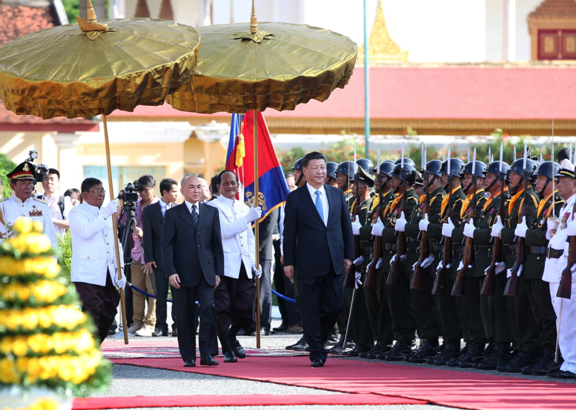Xi's Asia tour enhances ties, boosts cooperation
 0 Comment(s)
0 Comment(s) Print
Print E-mail China.org.cn, October 27, 2016
E-mail China.org.cn, October 27, 2016
Chinese President Xi Jinping paid state visits to neighboring Cambodia and Bangladesh and attended the 8th BRICS summit in the Indian state of Goa from October 13 to 17.
Renewing friendship
China has more neighboring countries than any other state in the world. A sound and stable neighborhood benefits everyone involved.
On October 13, Xi arrived in the Cambodian capital of Phnom Penh, his first trip to the Southeast Asian country as China's president.
Tens of thousands of local people gathered in the streets and square in front of the royal palace, holding the two countries' national flags, alongside flowers and portraits of leaders, to welcome the Chinese delegation. Cambodian King Norodom Sihamoni hosted a grand welcoming ceremony in the palace ahead of discussions. Besides the king, Xi also met with Cambodian Prime Minister Hun Sen and Cambodian Queen Norodom Monineath Sihanouk.
The two sides decided to further strengthen bilateral cooperation and signed a total of 31 cooperation documents covering fields such as economy, technology, infrastructure, human trafficking, taxation and maritime cooperation.
Both sides vowed to jointly safeguard and carry forward their traditional friendship forged and cultivated by Chinese and Cambodian leaders of previous generations, including Chairman Mao Zedong, Premier Zhou Enlai and Cambodian King Norodom Sihanouk.
Xi's trip to Cambodia reciprocates one made to Beijing by King Norodom Sihamoni this June, during which they agreed to further their comprehensive strategic cooperative partnership.
On October 14, Xi started his two-day "historic visit" -- as it was called by local newspapers -- to Bangladesh, the first by a Chinese head of state to the country in three decades.
The president was given the highest tribute possible for a foreign leader by the Bangladeshi side. The host country dispatched fighter jets to escort Xi's plane when it entered Bangladesh's airspace. Landing at the Dhaka airport, Xi was received by his Bangladeshi counterpart Abdul Hamid and given a 21-gun salute. Posters with pictures of Xi, Hamid and Prime Minister Sheikh Hasina adorned all major streets across the capital.
During the visit, the two countries agreed to upgrade their ties to a strategic partnership of cooperation, lifting the bilateral relationship to a new high.
The two sides signed a string of cooperation documents covering such areas as joint building of the Belt and Road, production capacity cooperation, information and telecom, energy and power, diplomatic affairs and maritime affairs. They also pledged to start feasibility studies on the establishment of a China-Bangladesh Free Trade Area.
In addition, they agreed to strengthen cultural and people-to-people exchanges and announced the year 2017 as the Year of Friendship and Exchange between China and Bangladesh.
Aligning strategies
Advancing the building of the Belt and Road and the Initiative's docking with other nations' development strategies is one of the most prominent aspects of Xi's Asia tour.
A transport hub in Southeast Asia, Cambodia holds a key position on the ancient maritime Silk Road that used to connect the East with the West.
During Xi's visit to the country, both sides decided to accelerate the alignment of China's "Belt and Road" Initiative and the 13th Five-Year Plan (2016-2020) with Cambodia's Rectangular Strategy and Industrial Development Policy 2015-2025.
China and Cambodia are constructing the Sihanoukville special economic zone in southwestern Cambodia, an example of collaboration under the "Belt and Road" Initiative. They are also about to expand concrete cooperation in sectors like trade, infrastructure and energy resources.
During his visit to Bangladesh, Xi pledged that China stands ready to push forward bilateral cooperation by aligning the development strategies of the two countries.
A series of infrastructure projects within the framework of the "Belt and Road" Initiative are under construction, including the Padma Bridge near the Bangladeshi capital of Dhaka, the underwater tunnel of Karnaphuli River in the country's southeast, the upgrade of power distribution system and the extension of the N8 highway to connect with the Padma Bridge. The two sides also plan to enhance communication and coordination in pushing forward the construction of the Bangladesh-China-India-Myanmar Economic Corridor.
Attending a dialogue between BRICS (Brazil, Russia, India, China and South Africa) and BIMSTEC (Bay of Bengal Initiative for Multi-Sectoral Technical and Economic Cooperation), Xi also called for the alignment of the "Belt and Road" Initiative and the BIMSTEC programs, so as to advance infrastructure construction and connectivity and strive for common development.
Proposed by Xi in 2013, the "Belt and Road" Initiative is aimed at building a trade and infrastructure network connecting Asia with Europe and Africa along ancient trade routes.
Polishing BRICS
As the BRICS cooperation mechanism marks its 10th anniversary this year, a gloomy allegation that "BRICS of gold is experiencing a fading shine" has loomed in some Western media.
However, the address delivered by Xi at the 8th BRICS summit held in Goa definitely disapproved this allegation and boosted the confidence of the BRICS countries.
According to the International Monetary Fund, the five BRICS countries contributed to more than half of the global growth in the last decade, Xi said in his speech, noting that the mechanism has actively pushed forward global economic governance reforms.
To face the challenges posed by a "complicated, severe external environment," Xi urged BRICS countries to cement confidence and put forward a five-point proposal -- building an open world, mapping out a shared development vision, coping with the most pressing global challenges, safeguarding fairness and justice in the international community and deepening partnerships within the bloc.
To jointly tackle global challenges such as climate change, infectious diseases and terrorism, the Chinese leader called for the five countries to strengthen coordination and communication in major international and regional issues.
To seek common development, Xi suggested the bloc member countries enhance cooperation, especially through the BRICS New Development Bank (NDB) and the Contingent Reserve Arrangement (CRA) that were established in 2014.







Go to Forum >>0 Comment(s)